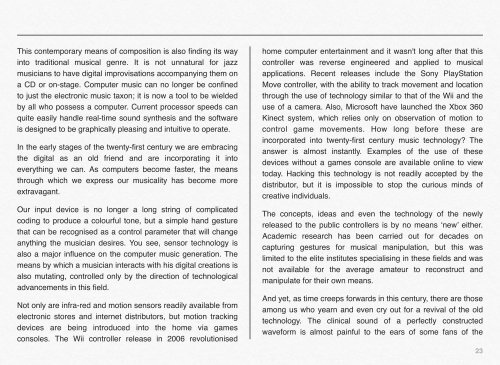Digital Arts & Humanities - Scholarly Reflections - James O'Sullivan
Digital Arts & Humanities - Scholarly Reflections - James O'Sullivan
Digital Arts & Humanities - Scholarly Reflections - James O'Sullivan
Create successful ePaper yourself
Turn your PDF publications into a flip-book with our unique Google optimized e-Paper software.
This contemporary means of composition is also finding its way<br />
into traditional musical genre. It is not unnatural for jazz<br />
musicians to have digital improvisations accompanying them on<br />
a CD or on-stage. Computer music can no longer be confined<br />
to just the electronic music taxon; it is now a tool to be wielded<br />
by all who possess a computer. Current processor speeds can<br />
quite easily handle real-time sound synthesis and the software<br />
is designed to be graphically pleasing and intuitive to operate.<br />
In the early stages of the twenty-first century we are embracing<br />
the digital as an old friend and are incorporating it into<br />
everything we can. As computers become faster, the means<br />
through which we express our musicality has become more<br />
extravagant.<br />
Our input device is no longer a long string of complicated<br />
coding to produce a colourful tone, but a simple hand gesture<br />
that can be recognised as a control parameter that will change<br />
anything the musician desires. You see, sensor technology is<br />
also a major influence on the computer music generation. The<br />
means by which a musician interacts with his digital creations is<br />
also mutating, controlled only by the direction of technological<br />
advancements in this field.<br />
Not only are infra-red and motion sensors readily available from<br />
electronic stores and internet distributors, but motion tracking<br />
devices are being introduced into the home via games<br />
consoles. The Wii controller release in 2006 revolutionised<br />
home computer entertainment and it wasn't long after that this<br />
controller was reverse engineered and applied to musical<br />
applications. Recent releases include the Sony PlayStation<br />
Move controller, with the ability to track movement and location<br />
through the use of technology similar to that of the Wii and the<br />
use of a camera. Also, Microsoft have launched the Xbox 360<br />
Kinect system, which relies only on observation of motion to<br />
control game movements. How long before these are<br />
incorporated into twenty-first century music technology? The<br />
answer is almost instantly. Examples of the use of these<br />
devices without a games console are available online to view<br />
today. Hacking this technology is not readily accepted by the<br />
distributor, but it is impossible to stop the curious minds of<br />
creative individuals.<br />
The concepts, ideas and even the technology of the newly<br />
released to the public controllers is by no means ‘new’ either.<br />
Academic research has been carried out for decades on<br />
capturing gestures for musical manipulation, but this was<br />
limited to the elite institutes specialising in these fields and was<br />
not available for the average amateur to reconstruct and<br />
manipulate for their own means.<br />
And yet, as time creeps forwards in this century, there are those<br />
among us who yearn and even cry out for a revival of the old<br />
technology. The clinical sound of a perfectly constructed<br />
waveform is almost painful to the ears of some fans of the<br />
23


